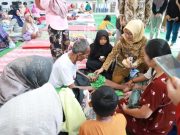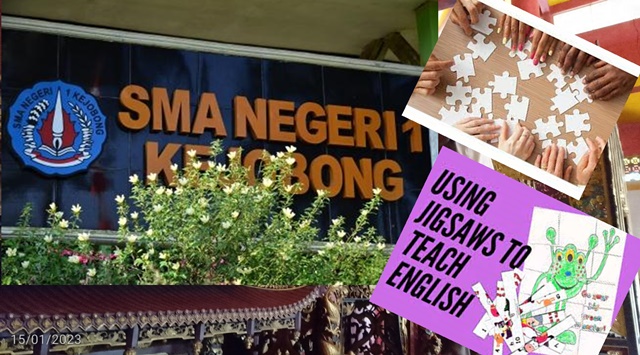By Singgih Budi Raharjo.S.Pd.
ENGLISH is not only used as a means of human communication but also as a subject learned at schools in Indonesia. The teaching of English is basically needed by Senior High School students because it is a compulsory subject in Senior High School. Then, English teachers who could conduct the teaching English well are needed.
Based on Kompas (30/10/2012) the result of the final examination in Senior High School is still low. There are some problems which influenced the result of the final examination. They are from the teacher itself, the method, and the motivation. As argued by Richard and Renandya (2002: 227), reading for comprehension is the primary purpose for reading. Therefore, students are always asked to comprehend reading texts by their teacher. In order to do that, it is expected that students are good readers who are able to comprehend a text effectively and efficiently.
The fact in the classroom of SMAN 1 Kejobong, especially in X grade the English teaching and learning is focused on helping the students pass the final exam only. Students are taught how to answer the questions and how to finish the questions of the final exam exercises with the time the teacher gives to the students. Additionally, teaching and learning processes take more time only in reading the texts and answering some questions related to the texts.
Unfortunately, the teacher is still the centre of the learning. As argued by Wichadee (2003:3) the teacher-centered approach taking place in traditional classrooms does not produce active recipients and results fossilized language learning. It is not effective enough to promote language acquisition.
Based on the information from the teacher and the researcher’s observation, teacher centre learning still happened to the X grade students in SMAN 1 Kejobong and the students tend not to listen the teacher because there is not variety of teaching, so many students are less motivated and feel bored in learning reading English in the classroom.
The students seldom discuss and share the materials at each other because the reading activity still depended on the teacher’s explanation. Then, the clever students tend to be active but the other students tend to be passive. These made the students not learn reading optimally and also made the students felt bored. Since students often feel bored in doing the reading activity above, they need new activities which are more challenging and interesting.
Many reading strategies need to be used to make the students active in doing reading comprehension activity. Harmer (2002) states that teaching reading is taught from elementary school to university by using many kinds of methods applied by English teacher. Cooperative learning may be considerably more effective for the students than the attention of the teacher only in the class. Working in group, therefore, is believed to solve the problem.
According to Wichadee (2003:1-2), the students who do not like to speak in the large class are comfortable speaking out in a small group. Group member can complete their strength and weakness in learning English reading because each student has a different background and ability in learning English which he or she can bring to the group. For example, one student may have strength in vocabulary that can supply to the students with a solid background grammar. Furthermore, slow student will be benefit from interaction with better one, and good student will feel proud they play an important role in helping their weaker classmates.
One problem of working in group method is the students are responsible to learn only their own subtopic or subtask and they do not learn their friend’s subtopic or subtask. For example, if one student has one topic of the reading text while his group must present all the topics to the class and also must answer all the topics from the teacher and other students, it will become dangerous for him and for his group.
Activities of Cooperative Methods
Jigsaw is one of the activities of cooperative methods which can solve this problem. Slavin (1995:111) says that in Jigsaw, most of working group include a procedure whereby students share information they have gathered with group mates and, in many cases, with the class as a whole. Students are quizzed on all topics and the quiz scores are averaged to form team scores.
So, if the team is to succeed, team members must not only accomplish their subtasks but also do a good job of sharing information with their teammates.
Based on the explanation above, teaching reading should encourage the student’s cooperation, in expressing idea, sharing idea, asking and explaining each other in a group so that the learning process of reading comprehension will achieve the better result.
That is why a new strategy or method to improve the students’ reading skill is needed to overcome the above problems.
Cooperative learning or group work method has several activities in the teaching learning. Jigsaw is one of the activities in the cooperative learning.
In cooperative learning, students cooperate with their friends to discuss the topic they study but when the students are given to study their own topic, it is the danger because the students tend only to study their own topic and the students do not want to study their friends’ topic.
Jigsaw is one of activities of cooperative methods which can solve this problem. Slavin (1995:111) says that Jigsaw includes a procedure whereby students share information they have gathered with their group mates and with the other group mate in the class. Students are quizzed on all topics and the quiz scores are averaged to form team scores.
So, if the team wants to be successful, the team members must not only accomplish their subtasks but also do a good job of sharing information with their teammates. They will be in the team consisting of various good students and weak students.
Every team consist of 4-5 students and they will study together to get better achievement in the form of individual improvement scores after taking the individual quiz. Every member in a team should be responsible for her/his own material to the member of his/her own team.
Steps in Implementing Jigsaw Technique in the Classroom: According to Aronson (1997), the jigsaw classroom is very simple use. These are the steps of jigsaw:
Dividing students into 4-5 person jigsaw groups. The groups should be diverse in terms of gender, ethnicity, race, and ability.
Appointing one student from each group as the leader. Initially, this person should be the most mature student in the group.
Dividing paragraph into jumble paragraph. For example,
Assigning each student to learn the jumble paragraph.
Giving students time to read the topic at least twice and become familiar with the topic.
From temporary “expert group” by having one student from each jigsaw group join other students assigned to the jumble paragraph. Give students to the expert groups time to discuss the main point of their jumble paragraph and to rehearse the presentation they will make to their jigsaw group.
Bringing the student back into their jigsaw group.
Asking each student to present her or his jumble paragraph to the group. Encourage others in the groups to ask questions for clarification.
Floating the group, observing the process, if any group is having trouble, (e.g., a member is dominating or disruptive), make an appropriate intervention. Eventually, its best for the group leader to handle task.
Leaders can be trained by whispering an instruction on how to intervene, until the leader gets the hang of it. At the end of the session, give a quiz on the material so that students quickly come to realize that these sessions are not just fun and game but really count.
Used jigsaw technique, teaching and learning reading became easier and helpful for the students because by using this technique the teacher asked the students to be active in the class and help the slow student.
The students who were in the team consisting of the good and the weak students could help each other. The fast students could help the slow students to comprehend the reading text cooperatively.
This technique could also help the slow students increase their confidence who were still afraid to answer the questions from the teacher and still felt shy to give their opinions when they were asked by the teacher. By using this technique, the slow students became more confident to study the reading text, to share and to ask the questions to their group mates.
By using this jigsaw technique, the students were not bored with the teaching and learning reading in the class compared with the teaching and learning in the previous meeting with their teacher. The teaching and learning reading was monotonous.
The teacher in the front of the class only asked the students to read the texts in the course book and asked the students to do the exercises from the course book. Considering that working in groups made the students tend to study their own topic and not learn their friends’ topic, the teacher used the quiz to avoid that problem.
In this quiz, the students were asked about all topics studied by them and the quiz scores were gained to form the team scores. All jigsaw groups wanted to be the winner, then team members did not only accomplish their subtasks but they also did a good job of sharing information with their team mates in order that all members could answer all questions.
This quiz could make all members of the jigsaw groups do the best for their team by trying to answer all questions to get the higher scores and to be the winner. The teacher made an interesting quiz and showed it to the students by using projector in the class. This quiz made the students not feel bored and sleepy because all students were interested to show their ability in comprehending the text by answering all the teacher’s questions.
They were also enthusiastic to do the quiz because they never got it before from their English teacher. As Aronson (1997:3) says that the quiz not only can check the students ‘comprehensions in reading texts but also can make the students quickly come to realize that these sessions are not just fun.
After the teacher conducted jigsaw technique, they were involved in the reading class. All students were enthusiastic in joining the reading class. They all were active in sharing and discussing their texts in their expert group and they all presented their texts to their jigsaw group mates. After she used jigsaw technique in the reading class, the students dared to share and ask their friends when they got the problems or when they did not know about the texts they read.
They could share and ask about their opinions more relaxed to their friends than they shared and asked their opinions to their teacher. the use of jigsaw technique is believed to improve students’ reading comprehension skill. And also the students became more interested and enthusiastic in the reading activities.
Based on the conclusions above, it can be implied that jigsaw technique can be used in the process of teaching and learning process because there are some advantages of using jigsaw technique for the students. First, jigsaw technique was a motivated technique.
Using jigsaw technique could make the students enthusiastic and gave some motivation to the students in reading narrative text. The students were motivated to comprehend the text because they must be able to present what they read to their jigsaw group mates. Second, jigsaw technique was an interesting technique. By using jigsaw technique, the students enjoyed learning English and enjoyed participating in the lesson.
Jigsaw technique was interesting for them in learning English because they never got this technique before and they got new learning technique in the class. They did not feel bored anymore because of using this technique in the reading class. Third, jigsaw technique was helpful.
Using jigsaw technique in reading activity was easier for the students to understand the text than they should read the text by themselves. By using this technique, they could ask and share their opinions with their group mates when they got the problems in reading their texts.
Singgih Budi Rahardjo, S.Pd., guru Bahasa Inggris di SMA Negeri 1 Kejobong, Purbalingga
















